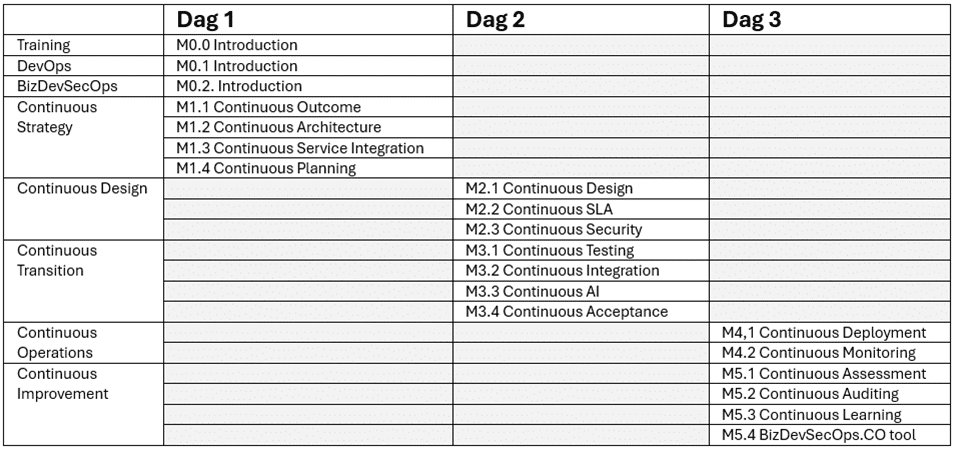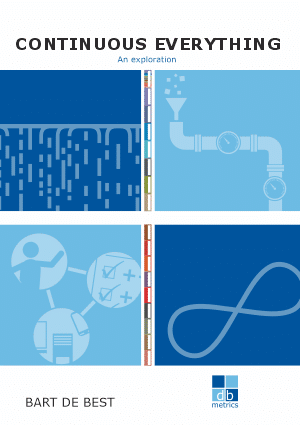CE Foundation Advanced – EN
Intro
Price: € 2475,-
Duration: 3 days
1. How to attend this masterclass
- The CE Foundation Advanced training is available online or in-person. In-company sessions or customised training are also possible.
- The training days are from 10:00 to 16:00.
- Evening sessions are from 18:30 to 21:30.
- To register, send an email to bartb@dbmetrics.nl
2. The content
The CE Foundation Advanced introduces the core concepts of the 19 Continuous Everything domains. DevOps continues to gain ground in the world of development (Dev) and operations (Ops). Major speed gains are being achieved in developing and deploying new functionality that supports business processes.
This is made possible by using new methods and techniques such as Continuous Integration (developers collaborating on the same codebase) and Continuous Deployment (automating the release of new functionality into production as much as possible).
More and more, we see the word “Continuous” being added in front of existing terms—like Continuous Monitoring and Continuous Security. That’s why we now talk about Continuous Everything (CE).
This training focuses on these CE best practices. You’ll get familiar with the related terminology at an introductory level. No prior knowledge is required, and there are follow-up courses and exams available for those who want to dive deeper.
3. Your profile
This CE Foundation Advanced training is suitable for anyone working in IT.
4. Content and learning objectives CE Foundation Advanced
This professional and practice-oriented CE Foundation Advanced training covers the core concepts and terminology of Continuous Everything (CE), explained through many real-world practical examples.
The training is aligned with Bloom’s Taxonomy:
- Bloom Level 1 – Ability to recall
- Bloom Level 2 – Ability to explain
- Bloom Level 3 – Ability to apply
Learning objectives:
- Acquire basic knowledge of DevOps (Bloom Level 1)
- Understand the core principles of DevOps (Bloom Level 2)
- Acquire basic knowledge of BizDevSecOps (Bloom Level 1)
- Understand what the best practice domains of Continuous Everything entail (Bloom Level 2)
- Recognise the interconnection between the CE best practices (Bloom Level 2)
- Learn the key elements of each CE domain (Bloom Level 2)
- Understand how knowledge and skills can be measured using Continuous Assessment and the www.BizDevSecOps.CO tool (Bloom Level 2)
- Be able to select relevant CE domains for your own roadmap (Bloom Level 3)
The following topics are covered during the training:

Day 1: Module 0 – Introduction
M0.0 Introduction training
M0.1. Introductie DevOps
- What is DevOps?
How DevOps came into existence?
Why DevOps?
What are the basic principles of DevOps?
M02. Introductie BizDevSecOps
- What is BizDevSecOps – more than just DevOps?
- Why is BizDevSecOps important?
- What is BizDevSecOps.CO?
- What publications exist on BizDevSecOps?
- What is the structure of the books?
Day 2: Module 1 – Continuous Strategy
M1.1 Continuous Architecture (CH)
- What is the definition of Continuous Architecture?
- What is the difference between SOR, SOE, and SOI?
- What is the Continuous Architecture model?
- How can architecture respond to the Agile world and help shorten time to market?
- How can Continuous Architecture be used to define the Service and Product roadmap?
M1.2 Continuous Service Integration (CR)
- What is Continuous Service Integration?
- What is the definition of Continuous Service Integration?
- How can a multi-vendor service be delivered to the customer as a single, unified service?
- What service integration patterns are available as options?
- How do the Continuous Everything value streams contribute to risk management in service integration?
M1.3 Continuous Planning (CP)
- What is the definition of Continuous Planning?
- What is the Continuous Planning value stream?
- What is the concept of Continuous Planning?
- What role does the Balanced Scorecard play in this?
- How can architecture be used to define a Product and Service Roadmap?
- How is this Roadmap translated into the product backlog and sprint backlog?
Day 2: Module 2 – Continuous Design
M2.1 Continuous Design (CN)
- What is the definition of Continuous Design?
- What is the Continuous Design pyramid model?
- How can an application design be shaped in an Agile way?
- What are the key design methods and techniques?
- How can these methods and techniques be integrated into a coherent whole?
- What is the relationship between the product backlog and the design artifacts?
M2.2 Continuous SLA (CQ)
- What is the definition of Continuous SLA?
- What is the Continuous SLA value stream?
- What is the Continuous SLA model?
- How can a service level manager identify the outcome needs?
- What is the relationship between a business value stream and the SLA?
- How does a Continuous SLA differ from a traditional SLA?
M2.3 Continuous Security (CY)
- What is the definition of Continuous Security?
- What is the Continuous Security value stream?
- What is an Information Security Value System?
- How can ISO 27001 be embedded in the Continuous Everything value stream?
- What is the difference between Continuous Security and Information Security Management?
Day 2: Module 3 – Continuous Transition
M3.1 Continuous Testing (CT)
- What is the definition of Continuous Testing?
- What is the Continuous Testing value stream?
- Why is Test Driven Development so important?
- What is Shift Left?
- What is the relationship between Continuous Integration (CI) and Continuous Testing (CT)?
M3.2 Continuous Integration (CI)
- What is the definition of Continuous Integration?
- What is the Continuous Integration value stream?
- How is source code developed?
- What is versioning?
- What is code refactoring?
- How is source code turned into binary code?
- What is incremental and iterative programming?
M3.3 Continuous AI (CZ)
- What is AI?
- What is the definition of Continuous AI?
- What is the Continuous AI value stream?
- What types of AI products are available on the market?
- How can AI enhance the Continuous Everything value stream?
M3.4 Continuous Acceptance (CC)
- What are acceptance criteria?
- What is the definition of Continuous Acceptance?
- What is the Continuous Acceptance value stream?
- How do you apply acceptance criteria within an Agile Way of Working (WoW)?
Day 3: Module 4 – Continuous Operations
M4.1 Continuous Deployment (CD)
- What is the definition of Continuous Deployment?
- What is the Continuous Deployment value stream?
- What is the OTAP street (Development, Test, Acceptance, Production)?
- What is a CI/CD secure pipeline?
- What repositories are needed?
- What is a Continuous Deployment roadmap?
M4.2 Continuous Monitoring (CM)
- What is the definition of Continuous Monitoring?
- What is the Continuous Monitoring layer model?
- What is the lead and lag performance indicator control model?
- What is the monitoring hierarchy model?
Day 3: Module 5 – Continuous Improvement
M5.1 Continuous Assessment (CS)
- What is the definition of Continuous Assessment?
- What is the Continuous Assessment value stream?
- What is a CE assessment?
- How is a CE assessment conducted?
M5.2 Continuous Auditing (CA)
- What is the definition of Continuous Auditing?
- What is the Continuous Auditing value stream?
- What is the Continuous Auditing pyramid?
- What is the concept of Continuous Auditing?
- What is the difference between Continuous Auditing and a traditional audit?
M5.3 Continuous Learning (CL)
- What is the definition of Continuous Learning?
- What is the Continuous Learning value stream?
- What is the Continuous Learning model?
- What is Bloom’s Taxonomy model?
- What is the Energy Level model?
M5.4. Continuous Outcome (CO)
- What is Continuous Outcome?
- What is the definition of Continuous Outcome?
- What is the Continuous Outcome value stream?
- What is a Business Value System?
- How can the business leverage the best practices of Continuous Everything?
M5.5 BizDevSecOps
- What is the mission and vision of the BizDevSecOps.CO tool?
- How can the BizDevSecOps.CO tool be used to support this?
- Demo
5. Prior knowledge and entry requirements CE Foundation Advanced
No specific prior knowledge is required to follow this CE Foundation Advanced training. It is useful to know basis terms of agile concepts like Agile Scrum and DevOps.
6. Training duration and costs
The CE Foundation Advanced training lasts 3 days. The costs for this training are: € 2475,-. This price includes digital teaching materials, coffee, tea and lunch and excludes VAT. The material for this CE Foundation Advanced training is delivered digitally. If you want to read the sheets on your own device during the training, you must bring your own device.

This training includes the book Continuous Everything – An Exploration.
ISBN: 978 949 1480 461
7. Exam
The costs for the Continuous Everything Foundation Advanced exam are €275 excl. VAT.
8. Certificate
If you have successfully completed the exam after the training, you will receive the Continuous Everything Foundation Advanced certificate.
9. Teachers
dbmetrics only works with the best teachers. Our trainers have extensive experience, are certified and have knowledge of theory and practice.
10. In-company
This training can also be organized in-company, under the guidance of one of our experienced consultants/trainers.
11. Advice and secondment
Are you looking for an experienced DevOps Engineer, product owner or scrum master or are you looking for good advice regarding setting up or optimizing your IT organization? Please contact dbmetrics.
